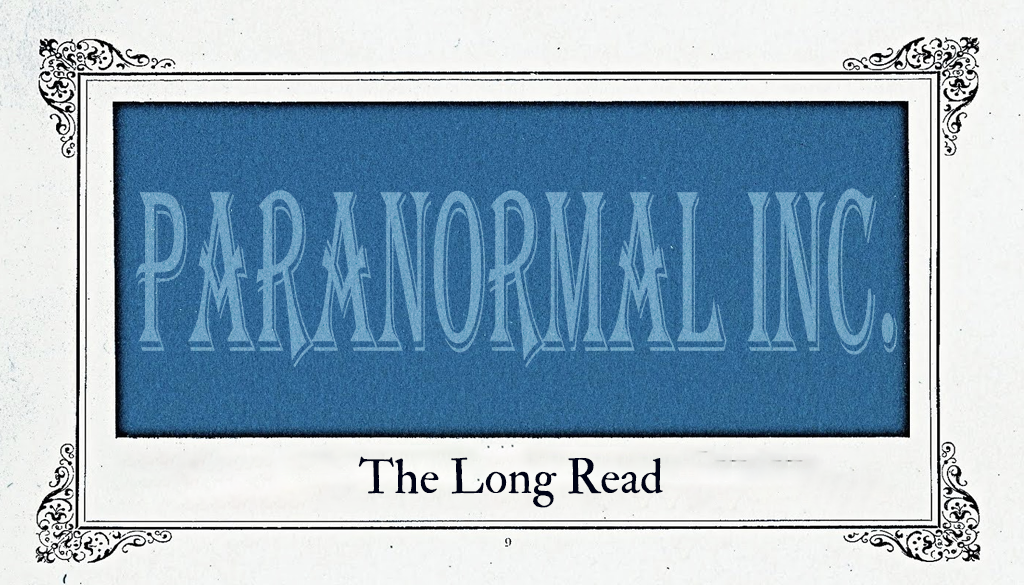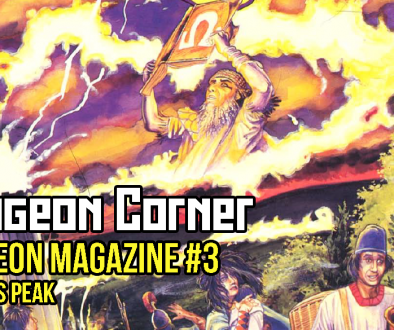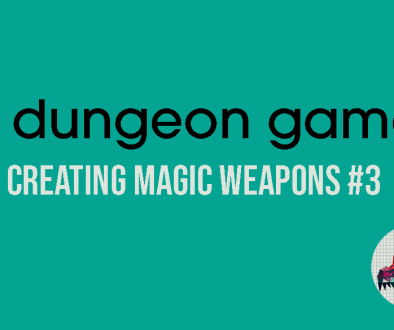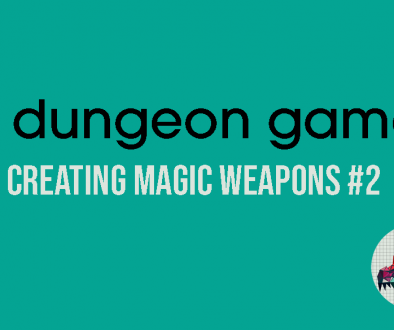Paranormal Inc.
This is a mirror of this Twitter thread, which was written in real time as I read Paranormal Inc. It hasn’t been edited in any way. You can pick up Paranormal Inc from Itch. You can also leave a tip at Ko-Fi if you like this kind of content and want to see more of it. I post these tweet mirrors to Detritus at least a week before they go live on Loot The Room. This post isn’t affiliated with or sponsored by Alicia Furness in any way. Thanks for reading.
I don’t have it in me to read a 200+ page trad game today, but last night we finished our Brindlewood Bay campaign and now feels like an excellent time to sit down with @AliciaFurness‘ Carved From Brindlewood game, Paranormal Inc.!

If you’re new here, here’s what’s going to happen.
I’m going to read the game, and I’m going to talk about it while I do it. That’s it.
It’s not a review, it’s just a first look. I may get things wrong. I may ask rhetorical questions.
Here’s what I know about Paranormal Inc going in.
I’ve worked with Alicia a lot and we talk regularly. We wrote our own Brindlewood Bay hack – Bed, Breakfast, and Beyond – and we’re working on another one. I’m obviously primed to like this. I’ve read an early, pre-layout draft because I’m supposed to be writing a mystery as a stretch goal for the Kickstarter (I’m very late and that’s my fault). So I’m passingly familiar with the game already, though I haven’t dug into it in depth. I really love Brindlewood Bay, too. Last night was our finale and it was the most fun, satisfying end to a campaign I’ve ever had.
So yeah. I’m going into this expecting the like what I see.
Let’s go. First up, the art is fantastic. It just sells the tone of the game immediately.

Oh shit that’s my name in the credits. I should really finish that mystery.

Those little ghosts along the bottom of the pages are amazing.
The introduction does exactly what it needs to – it tells us what the game is about, and it sets the tone we can expect. I think especially with ghosts, that’s super important.

This Discord Has Ghosts In It has a really good section about the tone of paranormal activity, and the difference between a ghost and a poltergeist. Poltergeists bring violence, rage, and aggression to your game in a way that other ghosts don’t. So these pop-culture touchstones do a good job of telling us that this game should be light-hearted and spooky for the most part, not heavy and dangerous. The next page tells us about the history of the world – why there are ghosts here, how the industry of paranormal investigation came to be, and how it was undercut by massive corporations like Definitely Not Amazon.
You have a bare-bones crew – a Scientist, a Medium, a Skeptic, and a Bookworm. Because I’ve read it before I know that these are the main playbooks players will choose from. There’s also a resident Ghost and an Intern.
We also learn that all your gear is 20 years out of date. I’m so drawn to the idea of a bunch of scrappy ghost hunters with aging tech desperately trying to keep the lights on. I love the idea that ghosts have just become a pest. We’re rat catchers with lasers and spirit traps.
I also like the explicit framing that this is a sci-fi game. Sure, there’s supernatural shit happening, but there’s probably an explanation for it.

Our next section introduces us to the idea of GMless games, as well as pointing us to the things we’ll need to play and talking about safety tools.
There’s no “what is an RPG?” section. The game assumes you’re familiar with the medium, and I think that’s totally fair. On to The Basics, which are very straightforward.
You read a mystery, answer the establishing questions, then draw cards to generate Locations, Clues, NPCs, and paranormal events.
A game is played in three phases: Introduction, Investigation, and Resolution. Each mystery tells you how many Clues you need to solve it in the Resolution phase (in Brindlewood Bay terms, this is the Complexity).
And that’s it, aside from a brief note that characters have Moves that they’ll use during play. It’s very, very straightforward. Brindlewood Bay uses the trad setup of a GM with a mystery and a group of players who discover it through play, but Paranormal Inc. is GMless. Alicia has basically turned a deck of cards into the GM, and that requires some (very easy) setup. Before you play you’ll take a deck of cards, remove all the face cards, and split it into 4 shuffled piles of A-10, one for each suit.
These form your Location, Paranormal Event, NPC, and Clue decks.
There are also tips for how to play online, and a link to online cards. After set-up we get the basics of how the dice work, which I think most people reading this will already be anticipating because it’s PbTA – you roll dice when a Move is triggered, and it’s generally 2d6+Ability. 7+ is generally a hit and 6- a miss, but Moves are more specific. You also might sometimes roll with Advantage (roll 3 dice and keep the highest 2).
Most of the time you get Advantage by using equipment (which comes from your Backpack), or because a Move gives you advantage. The same goes for Disadvantage, which may be imposed by conditions or by card prompts listing temporary disadvantages. The next section tells us about Personal Hauntings, which replace Brindlewood Bay’s Crowns. These are a fictional currency that let you increase the result of a roll by one band (i.e. a 6- becomes a 7-9, a 7-9 becomes a 10, etc).
We aren’t yet shown exactly how Personal Hauntings work, other than that you can use them to experience death and violence without fully committing to it (because once you see the outcome you don’t like, you take a Haunting and raise your roll to a more beneficial one). If they’re anything like Brindlewood Bay’s Crowns, though, Personal Hauntings will involve narrating a specific scene from your character’s life and then marking it off on your sheet, and each character will have a limited number to use. We’ll see when we get there.
Before we find out more about Personal Hauntings, we’re given the structure of play. Most of the game takes place in the Introduction and Investigation phases. Players draw a Location card, answer the Establishing Question, and then draw a Paranormal Event for that Location. This basically kick-starts a scene, which you play out by investigating the room, talking to each other, and using Moves as appropriate. If it makes sense to draw an NPC card you do that, and when someone succeeds on the Discovery move you draw a Clue.
We haven’t fully been shown this yet, but one thing I really like about how the game works is that each Clue cars (and, IIRC, each Paranormal Event card) has three prompts on it. You always have choices in a scene, & you’re never stuck trying to force something to work that won’t.
The next section is an example of play, and it’s really good because – having played a lot of Brindlewood Bay – it very accurately represents what play actually looks like rather than an idealised version of it. One thing my group struggled with in Brindlewood Bay was expecting me to have all the answers already. They’d want to talk to a character to ask specific questions, rather than with the goal of gaining a clue, and it took a couple of sessions for them to adjust to that. This example of play shows us how it’s actually meant to work.
I also think the GMless angle helps with this, too. Nobody is going to cling on to the trad mindset that the GM knows everything because there’s no GM and everyone has the same level of information to hand. After a more detailed description of what to expect when you draw cards (i.e. look up the card on the prompt table and integrate what you’re told into the narrative) we move on to General Moves. These are the bread and butter of character action. The Risky Move maps almost exactly onto Brindlewood Bay’s Day and Night Moves, and it’s the main thing you’ll be using to resolve actions that aren’t linked to trying to find clues. You try to do something risky, and you either succeed or succeed with consequences.
The Ghostly Encounters move is a nice twist on the Cozy Move from Brindlewood, and something that I think will come up way more often. You use it to clear conditions, to deepen your relationships with other characters, and potentially to find clues. The Cozy move didn’t come up much for us, but because triggers when you encounter a ghost it feels much more useful. The Discovery Move is basically identical to The Meddling Move, and that’s 100% okay because that move does exactly what it needs to do to uncover clues.
The main difference is that we don’t have Void Clues here, so on a 12 or above you instead find 2 clues. (For those who don’t know, the larger framing device of Brindlewood Bay is that there’s a dark conspiracy involving a secret chthonic cult linking all the murders. As you uncover Void Clues in your investigations, you learn more about the conspiracy that’s unfolding.)
This piece of art is wonderful.

The Handbook Of The Recently Deceased move replaces the Gold Crown Mysteries move. Mechanically this is just a once-per-session 12+ on any roll, but fictionally it’s the most fun move in the game because you get to just make shit up that becomes fact in your world. It’s triggered by a player saying, “Inrwad about this in the Handbook of the Recently Deceased!” and then you work together to figure out what was in the book and how it’s relevant to the current situation.
It’s magic. The final general move is my favourite piece of PbtA tech, the real magic that makes Brindlewood Bay what it is.
The Theorize Move.
The text here is exactly the same as in Brindlewood Bay and that’s fine because as a move it’s perfect. Theorize happens when the Investigators have “an open, freewheeling discussion about the solution to a mystery based on the Clues they have uncovered and reach a consensus”. As a GM running Brindlewood Bay, I was always a little worried when we got to Theorize because I’d look at the list of clues and think, “how the hell can they link all of these into a solution?”
And every single week I was amazed at the things that the group came up with. Theorize took our games into places I never could have predicted or come up with myself. It’s the magic of group storytelling in one move – and when you roll and hit and your mad theory is right, it’s really satisfying. And that’s all of the basic moves! It’s nice and simple – the game doesn’t ask anybody to memorize loads of abilities or subsystems. The next section gets into The Anatomy Of A Mystery. I’m going to take a quick break from this to grab some lunch, and then I’ll get back to it. Okay we’re back and it’s Anatomy Of A Mystery time.
Mysteries are the core of the game. You can either play one of the pre-existing mysteries, or else write your own. With a traditional GMed game it’s fairly straightforward for a GM to just wing a session, but with a GMless game that’s not possible – which means you always need a mystery, so there will always be a base level of prep.
One thing I really like in Paranormal Inc. is the instruction to split up the work of prepping a mystery between all the players (if you’re writing your own mystery). This ensures that the task doesn’t fall to just one person, and that everyone can still be surprised.
Moving on to character creation, we find our first real difference between Paranormal Inc. and Brindlewood Bay – playbooks! Brindlewood Bay doesn’t have playbooks in the traditional sense. Instead, players choose an individual Maven move to distinguish their character.
We have four stats – Science, Wits, Vigour, and Intuition. We assign +1, 0, 0, and -1 to each stat, and then we modify one of them with a +1. Each playbook also has its own unique Personal Hauntings as opposed to the shared crowns of Brindlewood Bay, and I really like that. The way the playbooks are presented is really evocative. We get a two word description of what role each playbook fills, and an excerpt from the Book Of The Recently Deceased about them. Here are the playbooks:
The Scientist – Tests Things
The Skeptic – Doubts Things
The Medium – Senses Things
The Intern – Fetches Things
The Bookworm – Knows Things
The Ghost – Possesses Things
Let’s talk for a second about the way these characters are presented in art, too. We’ve got real variety in terms of body type, age, race. And the art is amazing and evocative all the way through this book, too.

Every playbook gets to choose 2 moves from a selection of 3 and they’re all great. Favourites include Experimental Technology, which gives you some untested tech that may or may not work; I Know Just The Person! that gives you a helpful NPC you can call on; and Filled With Regret
Filled With Regret is from the Ghost playbook, and says, “When you have a ghostly encounter, you may allow yourself to be possessed by the other ghost. Narrate a regretful memory for the ghost’s past. Then, mark a Personal Haunting to discover a Clue.”
Love. It. I haven’t really talked about the Personal Hauntings, but each playbook gets its own track and they’re all very evocative and really get into who these characters are. This is the Personal Haunting track for the Ghost.

The fact that the mysteries have lower complexities than Brindlewood Bay, there’s no Dark Conspiracy, and each playbook only gets 5 Personal Hauntings tells me that this is intended to be a shorter-lived game than Brindlewood Bay. And that’s fine! My Brindlewood campaign was very compressed – it lasted 6 sessions, which was too short for Brindlewood Bay really (we had to accelerate the dark conspiracy) but I think it would be perfect for Paranormal Inc.
The final section is Midnight Feast, a complexity 4 introductory mystery by Alicia. It takes place in the alley behind the Paranormal Inc headquarters, and involves investigators trying to make their new neighbours move on – either to the next world or another part of town. It’s a fun mystery with some really cool prompts and clues that I’m not going to spoil here, because this is likely to be the first mystery people play – and you should absolutely play Paranormal Inc. I really like this game.
If there’s one thing I’d like to see in it that isn’t there, it’s more stuff around the Paranormal Inc. headquarters itself. Brindlewood Bay centres itself around the room at the top of the Candlelight Booksellers, and I found that fleshing that space out and returning to it often really grounded the characters in the world. BUT most of that work of fleshing out that space is done by mysteries, not the game text itself, and so this is only the most minor of…not even criticism, really, just vague wish for something else. And it’s easily fixed in play by asking a few questions about the space. And that’s the game! There are more mysteries available, and more to come in future (whenever I turn mine in – sorry Alicia 😬)
You can grab it in print here (and you should, the zine is gorgeous).
Or in PDF here.
If you enjoyed this post please consider leaving a tip at Ko-Fi.




